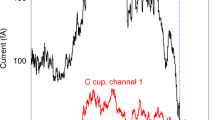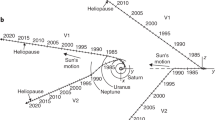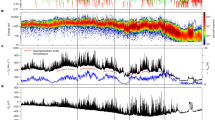Abstract
Voyager 2 crossed the solar wind termination shock at 83.7 au in the southern hemisphere, ∼10 au closer to the Sun than found by Voyager 1 in the north1,2,3,4. This asymmetry could indicate an asymmetric pressure from an interstellar magnetic field5,6, from transient-induced shock motion7, or from the solar wind dynamic pressure. Here we report that the intensity of 4–5 MeV protons accelerated by the shock near Voyager 2 was three times that observed concurrently by Voyager 1, indicating differences in the shock at the two locations. (Companion papers report on the plasma8, magnetic field9, plasma-wave10 and lower energy particle11 observations at the shock.) Voyager 2 did not find the source of anomalous cosmic rays at the shock, suggesting that the source is elsewhere on the shock12,13,14 or in the heliosheath15,16,17,18,19. The small intensity gradient of Galactic cosmic ray helium indicates that either the gradient is further out in the heliosheath20 or the local interstellar Galactic cosmic ray intensity is lower than expected21.
This is a preview of subscription content, access via your institution
Access options
Subscribe to this journal
Receive 51 print issues and online access
$199.00 per year
only $3.90 per issue
Buy this article
- Purchase on Springer Link
- Instant access to full article PDF
Prices may be subject to local taxes which are calculated during checkout



Similar content being viewed by others
References
Stone, E. C. et al. Voyager 1 explores the termination shock region and the heliosheath beyond. Science 309, 2017–2020 (2005)
Burlaga, L. F. et al. Crossing the termination shock into the heliosheath: Magnetic fields. Science 309, 2027–2029 (2005)
Decker, R. B. et al. Voyager 1 in the foreshock, termination shock, and heliosheath. Science 309, 2020–2024 (2005)
Gurnett, D. A. & Kurth, W. S. Electron plasma oscillations upstream of the solar wind termination shock. Science 309, 2025–2027 (2005)
Opher, M., Stone, E. C. & Liewer, P. C. The effects of a local interstellar magnetic field on Voyager 1 and 2 observations. Astrophys. J. 640, L71–L74 (2006)
Pogorelov, N. V., Stone, E. C., Florinski, V. & Zank, G. P. Termination shock asymmetries as seen by the Voyager spacecraft: The role of the interstellar magnetic field and neutral hydrogen. Astrophys. J. 668, 611–624 (2007)
Washimi, H., Zank, G. P., Hu, Q., Tanaka, T. & Munakata, K. A forecast of the heliospheric termination-shock position by three-dimensional MHD simulations. Astrophys. J. 670, L139–L142 (2007)
Richardson, J. D., Kasper, J. C., Wang, C., Belcher, J. W. & Lazarus, A. J. Cool heliosheath plasma and deceleration of the upstream solar wind at the termination shock. Nature 10.1038/nature07024 (this issue)
Burlaga, L. F. et al. Magnetic fields at the solar wind termination shock. Nature 10.1038/nature07029 (this issue)
Gurnett, D. A. & Kurth, W. S. Intense plasma waves at and near the solar wind termination shock. Nature 10.1038/nature07023 (this issue)
Decker, R. B. et al. Mediation of the solar wind termination shock by non-thermal ions. Nature 10.1038/nature07030 (this issue)
McComas, D. J. & Schwadron, N. A. An explanation of the Voyager paradox: Particle acceleration at a blunt termination shock. Geophys. Res. Lett. 33, L04102 (2006)
Kóta, J. Anomalous cosmic rays at a blunt termination shock. Proc. 30th Int. Cosmic Ray Conf. (in the press)
Schwadron, N. A., Lee, M. A. & McComas, D. J. Diffusive acceleration at the blunt termination shock. Astrophys. J. 675, 1584–1600 (2008)
Ferreira, S. E. S., Potgieter, M. S. & Scherer, K. Transport and acceleration of anomalous cosmic rays in the inner heliosheath. J. Geophys. Res. 112 A11101 10.1029/2007JA012477 (2007)
Fisk, L. A., Gloeckler, G. & Zurbuchen, T. H. Acceleration of low-energy ions at the termination shock of the solar wind. Astrophys. J. 644, 631–637 (2006)
Langner, U. W. & Potgieter, M. S. Possible explanations of anomalous spectra observed with Voyager 1 crossing the solar wind termination shock. AIP Conf. Proc. 858, 233–238 (2006)
Moraal, H. et al. Cosmic ray energy changes at the termination shock and in the heliosheath. AIP Conf. Proc. 858, 219–225 (2006)
Zhang, M. Acceleration of galactic and anomalous cosmic rays in the heliosheath. AIP Conf. Proc. 858, 226–232 (2006)
Florinski, V. et al. Galactic cosmic ray transport in the global heliosphere. J. Geophys. Res. 108 A1228 10.1029/2002JA009695 (2003)
Webber, W. R. & Lockwood, J. A. Voyager and Pioneer spacecraft measurements of cosmic ray intensities in the outer heliosphere: Toward a new paradigm for understanding the global solar modulation process: 1. Minimum solar modulation (1987 and 1997). J. Geophys. Res. 106, 29323–29332 (2001)
Florinski, V. & Zank, G. P. Particle acceleration at a dynamic termination shock. Geophys. Res. Lett. 33, L15110 (2006)
Jokipii, J. R. Energetic particles near and beyond the solar-wind termination. AIP Conf. Proc. 858, 143–152 (2006)
Kóta, J. & Jokipii, J. R. Implications of the Voyager-1 particle spectra for acceleration at the termination shock. AIP Conf. Proc. 858, 171–176 (2006)
Cummings, A. C. & Stone, E. C. Possible role of transients on the energy spectra of energetic particles at the solar wind termination shock. Proc. 30th Int. Cosmic Ray Conf. (in the press)
McDonald, F. B. et al. Observations of energetic ions and electrons in the distant heliosphere: 2001 - 2005.0. AIP Conf. Proc. 781, 261–266 (2005)
Ferreira, S. E. S. & Potgieter, M. S. The modulation of 4- to 16-MeV electrons in the outer heliosphere: Implications of different local interstellar spectra. J. Geophys. Res. 107 A1221 10.1029/2001JA000226 (2002)
Gloeckler, G. & Fisk, L. A. Anisotropic beams of energetic particles upstream from the termination shock of the solar wind. Astrophys. J. 648, L63–L66 (2006)
Giacalone, J. & Jokipii, J. R. Energetic particle intensities and anisotropies near the solar wind termination shock. Astrophys. J. 649, L137–L140 (2006)
Jokipii, J. R., Giacalone, J. & Kóta, J. Transverse streaming anisotropies of charged particles accelerated at the solar wind termination shock. Astrophys. J. 611, L141–L144 (2004)
Acknowledgements
This work was supported by NASA (NAS7-03001).
Author information
Authors and Affiliations
Corresponding author
Rights and permissions
About this article
Cite this article
Stone, E., Cummings, A., McDonald, F. et al. An asymmetric solar wind termination shock. Nature 454, 71–74 (2008). https://doi.org/10.1038/nature07022
Received:
Accepted:
Issue Date:
DOI: https://doi.org/10.1038/nature07022
This article is cited by
-
Where solar wind meets interstellar medium
Nature Astronomy (2023)
-
Future Exploration of the Outer Heliosphere and Very Local Interstellar Medium by Interstellar Probe
Space Science Reviews (2023)
-
Parker Solar Probe: Four Years of Discoveries at Solar Cycle Minimum
Space Science Reviews (2023)
-
Oblique and rippled heliosphere structures from the Interstellar Boundary Explorer
Nature Astronomy (2022)
-
Backscattered Solar Lyman-$\alpha $ Emission as a Tool for the Heliospheric Boundary Exploration
Space Science Reviews (2022)
Comments
By submitting a comment you agree to abide by our Terms and Community Guidelines. If you find something abusive or that does not comply with our terms or guidelines please flag it as inappropriate.



